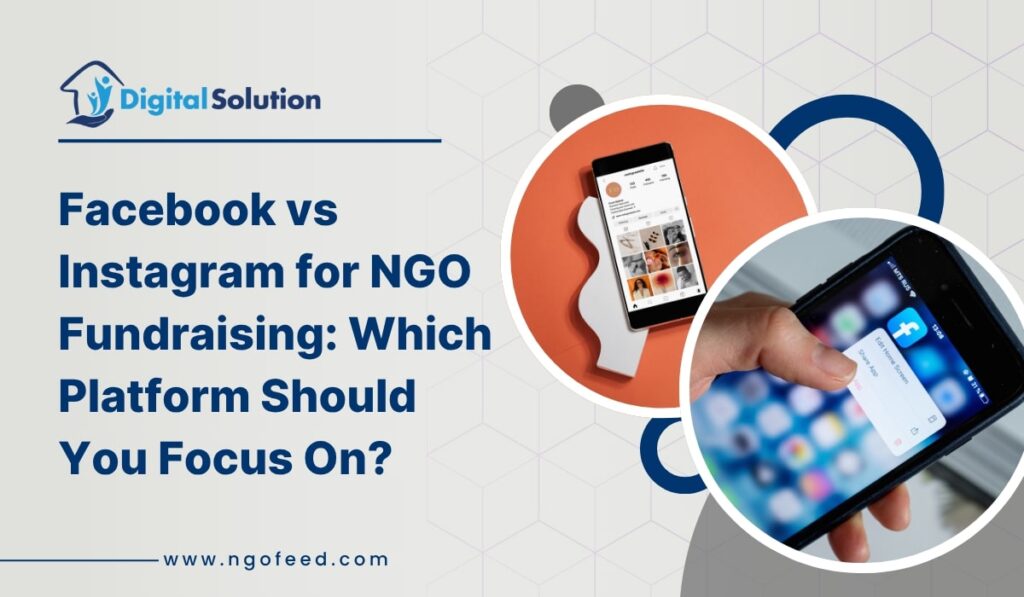Facebook vs Instagram for NGO Fundraising: NGOs are no longer limited to offline contributions or conventional means of fundraising in the digital-first world of today. Emerging as a strong means of organizing resources, increasing knowledge, and interacting with many communities are social media channels. Among these platforms, Facebook and Instagram emerge as major participants. Still, everyone has different benefits and drawbacks for fundraising. Knowing these distinctions will enable NGOs to select the ideal platform, or a mix of both, for maximum effect.
Table of Contents
Facebook vs Instagram for NGO Fundraising – Facebook as an NGO revenue generator
Facebook’s advantages
- Facebook provides direct fundraising tools like peer-to-peer donation campaigns, birthday fundraisers, and “Donate Now” buttons.
- Facebook remains a good option for nonprofits seeking to reach a wide range of donors given its users across age groups, especially 25–45.
- Long-term interaction with fans is made simpler by groups, sites, and activities, which promotes community building.
- NGOs can use Facebook Ads to target prospective donors depending on location, hobbies, and behavior.
Drawbacks of Facebook
- Reduced visibility of unpaid NGO articles is brought about by algorithm changes. Many times, paid advertising is required.
- Many younger donors (Gen Z) are less active on Facebook than on Instagram and TikTok.
- NGOs have to register with Facebook Payments or outside processors, which can be challenging.
NGO fundraising on Instagram
Strengths of Instagram:
- Instagram is perfect for NGOs distributing powerful stories since it depends on powerful visuals and brief films (Reels, Stories).
- Younger Audience: Understanding that a significant percentage of Instagram’s audience is under 35 is vital for reaching out to the next generation of contributors.
- NGOs can work with social media influencers to raise funds and increase the reach of campaigns.
- Instagram offers “Donate” stickers in Stories, fundraisers in Reels, and integration with Facebook’s donation tools.
Disappointments of Instagram
- Instagram values pictures, hence sophisticated project specifics can be difficult to share.
- High content saturation implies NGOs need to invest in innovative methods to be noticeable.
- Short Attention Span: Users frequently scroll quickly; therefore NGOs must immediately capture attention with powerful images.
Key Differences Between Facebook vs Instagram for NGO Fundraising
| Feature/Aspect |
|---|
| Fundraising Tools | Donate button, birthday fundraisers, group fundraisers | Donate stickers in Stories, Reels fundraisers |
| Primary Audience | 25–45+, family-oriented, wider reach | Under 35, highly visual, youth-driven |
| Content Type | Mixed: text, images, video, links | Primarily visuals, short-form video |
| Community Building | Strong: Groups, Events, Pages | Moderate: Followers, Engagement via Stories |
| Organic Reach | Declining, needs ads | Stronger with creative visuals |
| Best Use Case | Large campaigns, peer-to-peer giving | Storytelling, youth donor engagement |
Which Platform Should Your NGO Focus On?
The response depends on your NGO’s target, audience, and fundraising objectives:
Select Facebook if:
- You hope to appeal to a wide audience, including middle-aged donors with greater discretionary income.
- With peer-to–peer giving and neighborhood groups, you want to conduct organized fundraising initiatives.
- Long-form contact and strong advertising targeting are required.
Pick Instagram if:
- You hope to create sustained donor ties and involve young people.
- Your NGO possesses good visual storytelling material (e.g., brief-impact films, pictures of fieldwork).
- You intend to make use of viral campaigns and influencers.
Best Approach: A Hybrid Approach:
- Instagram can help you to raise awareness, draw in younger audiences, and elicit emotional involvement.
- Turn that awareness into ordered donations, long-running initiatives, and community-based giving using Facebook.
Hints for NGOs to Maximize Social Media Funding
- Buy storytelling: Actual human narratives with powerful visuals outperform basic updates.
- Employ live sessions and short videos to significantly improve interaction.
- Assign limited budgets for targeted advertisements to increase conversions and reach.
- Encourage Peer-to-Peer Giving: Supporters may raise money for NGOs on both services.
- Regularly inform donors on fund usage to create trust. Maintain Transparency.
Final Thoughts
In NGO fundraising, Instagram and Facebook both have important roles. Facebook shines in organized giving and long-term community building, but Instagram excels in youth involvement and visual narrative. NGOs should use a supplementary approach instead of selecting just one: Instagram for reach and interaction and Facebook for organized fundraising and retention. This dual strategy maximizes fundraising potential while guaranteeing NGOs stay relevant across generations.
Frequently Asked Questions (FAQs)
Q1: Is it possible to link Facebook and Instagram fundraising campaigns?
Yes, since Instagram fundraising tools are powered by Facebook, NGOs can manage both platforms’ campaigns through a single backend.
Q2: Which platform has higher donation conversion rates?
Facebook generally has higher conversion rates due to its structured donation tools, but Instagram offers stronger engagement that leads to future donations.
Q3: Do NGOs need special approval to use Facebook/Instagram fundraising tools?
Yes, NGOs must be registered as charitable organizations with Facebook and comply with payment processor requirements.
Q4: Should NGOs invest in paid ads for fundraising?
Yes, organic reach is limited. Small ad spends on both platforms can significantly boost visibility and donations.
Q5: Can smaller NGOs with limited resources succeed on Instagram?
Absolutely. Instagram’s emphasis on visuals and storytelling makes it ideal for grassroots NGOs with authentic, relatable content.



